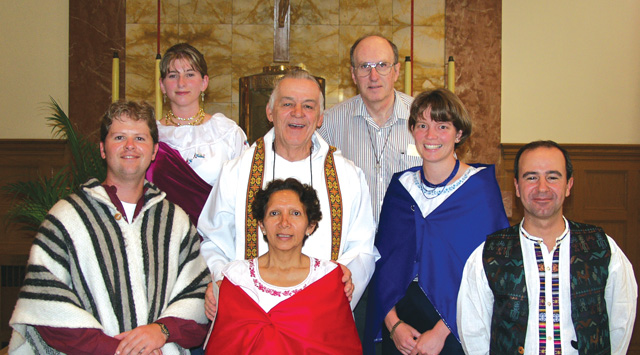Scarboro in Ecuador
Walking with the people and supporting efforts based on the seeds of justice sown by Monsignor Leónidas Proaño, “bishop of the Indigenous”
By Julia Duarte
January/February 2013
Return to Table of Contents
Print Article
To speak of Scarboro’s mission to Ecuador is to speak of a team working together to achieve the different tasks assigned by Monsignor Victor Corral Mantilla, bishop of the Diocese of Riobamba.
 Some members of the Ecuador mission team. Photo taken in 2007.
Some members of the Ecuador mission team. Photo taken in 2007.Back row: Anne Quesnelle and Fr. Frank Hegel; middle row: Fr. Charlie Gervais and Carolyn Beukeboom; front row: Marc Chartrand (husband to Anne Quesnelle), Julia Duarte, and Ignacio Pinedo, now an ordained priest for the Archdiocese of Toronto.
Scarboro accepted this invitation by Bishop Corral principally because the diocese was predominantly Indigenous and the work would be based on the seeds of justice that had been sown by the previous bishop, Monsignor Leónidas Proaño, known internationally as the bishop of the Indigenous because of his stand in giving voice to the voiceless. Bishop Proaño’s fight, based in the Gospels, was to win equality and dignity for the Indigenous who for many years had lived as slaves on the estates of the large landowners.
When the Scarboro team arrived in Ecuador, Bishop Proaño’s work was beginning to bear fruit. The Indigenous, “those without voice,” were making inroads not only in the Church through active participation and through the seminary for Indigenous young men, but also in the political arena through organizations such as the Indigenous Movement of Chimborazo and the Confederation of Indigenous Nationalities of Ecuador (CONAIE). The urban and rural poor of Ecuador, organized within Base Christian Communities, were the motor driving a new conception of Church and they were demanding commitment and lifestyle witness.
Into this context of new ideas and hopes, the new Scarboro team inserted itself and tried to support the people’s efforts. One of the peculiarities of Scarboro in Ecuador was the composition of the team: multidisciplined, multiethnic, and multigenerational, composed of Scarboro laity along with two Scarboro priests who were there at different moments, never together.
Diverse areas of work
Each missionary focused on specific works in diverse areas: community health care; pastoral assistance to the aged and infirm; adult education to urban, rural and indigenous communities; organization and work with women; formation of indigenous and mestizo priest candidates at the new seminary; helping young children with their homework and assisting in the education and formation of older youth to bring them up to national education standards; providing scholarships to enable poor families to continue their children’s education beyond elementary school; pastoral and sacramental work in the parishes; collaborating in community economic development programs; providing lunch service for the abandoned elderly at the cathedral; community and eco-tourism development in the Puruhá Indigenous communities on the snow covered slopes of Mount Chimborazo.
The best legacy left by Scarboro in Riobamba Diocese was the testimony of a diverse group of missionaries with independent responsibilities who were able to collaborate and support one another with open hearts and minds.
There was a lot of missionary activity with the marginalized in an effort to meet the human and economic needs of the people in the diocese, with the help of various Canadian organizations that Scarboro invited to participate in this work.
With no specific territory for Scarboro’s work, nor a particular parish assigned, I consider that the best legacy left by Scarboro missionaries in the Diocese of Riobamba was the testimony of a diverse group of missionaries with independent responsibilities who were able to collaborate and support one another with open hearts and minds.
Cooperation in the area of simple daily chores, equality and openness in team relationships as well as the commitments assumed by the team are not only part of Scarboro’s legacy in Ecuador, but also an enriching way of life that even strengthened the lives of each person on the missionary team.
As with all missionary work, the legacy and richness of the experience lived is mutual and the Scarboro team received a lot more than it gave and was evangelized by the love and solidarity lived among those who had the least. They learned to value and enjoy the artistic expressions of the ancient cultures, created new friendships and lived so many personal experiences, helping many to discover a new reality that was formerly unknown.
Julia Duarte and her husband Tom Walsh served with Scarboro for many years. They now live in Nicaragua.
Return to Table of Contents
Print Article